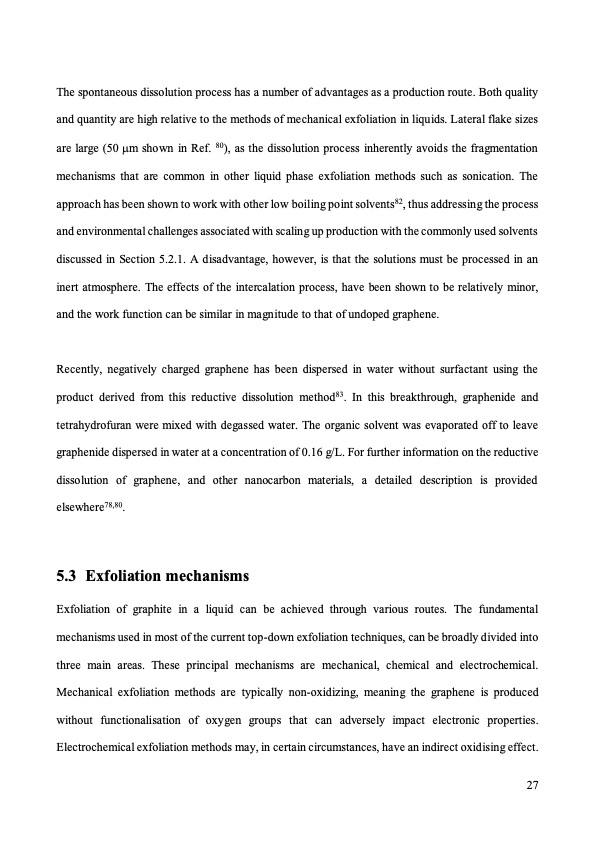PDF Publication Title:
Text from PDF Page: 027
The spontaneous dissolution process has a number of advantages as a production route. Both quality and quantity are high relative to the methods of mechanical exfoliation in liquids. Lateral flake sizes are large (50m shown in Ref. 80), as the dissolution process inherently avoids the fragmentation mechanisms that are common in other liquid phase exfoliation methods such as sonication. The approach has been shown to work with other low boiling point solvents82, thus addressing the process and environmental challenges associated with scaling up production with the commonly used solvents discussed in Section 5.2.1. A disadvantage, however, is that the solutions must be processed in an inert atmosphere. The effects of the intercalation process, have been shown to be relatively minor, and the work function can be similar in magnitude to that of undoped graphene. Recently, negatively charged graphene has been dispersed in water without surfactant using the product derived from this reductive dissolution method83. In this breakthrough, graphenide and tetrahydrofuran were mixed with degassed water. The organic solvent was evaporated off to leave graphenide dispersed in water at a concentration of 0.16 g/L. For further information on the reductive dissolution of graphene, and other nanocarbon materials, a detailed description is provided elsewhere78,80. 5.3 Exfoliation mechanisms Exfoliation of graphite in a liquid can be achieved through various routes. The fundamental mechanisms used in most of the current top-down exfoliation techniques, can be broadly divided into three main areas. These principal mechanisms are mechanical, chemical and electrochemical. Mechanical exfoliation methods are typically non-oxidizing, meaning the graphene is produced without functionalisation of oxygen groups that can adversely impact electronic properties. Electrochemical exfoliation methods may, in certain circumstances, have an indirect oxidising effect. 27PDF Image | graphene production via nonoxidizing liquid exfoliation

PDF Search Title:
graphene production via nonoxidizing liquid exfoliationOriginal File Name Searched:
Graphene-R2-review.pdfDIY PDF Search: Google It | Yahoo | Bing
Salgenx Redox Flow Battery Technology: Power up your energy storage game with Salgenx Salt Water Battery. With its advanced technology, the flow battery provides reliable, scalable, and sustainable energy storage for utility-scale projects. Upgrade to a Salgenx flow battery today and take control of your energy future.
CONTACT TEL: 608-238-6001 Email: greg@infinityturbine.com (Standard Web Page)